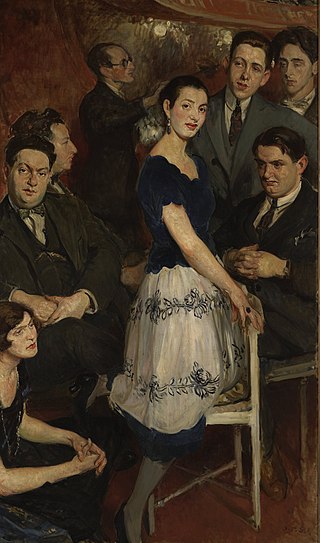Related Research Articles

"Les Six" is a name given to a group of six composers, five of them French and one Swiss, who lived and worked in Montparnasse. The name has its origins in two 1920 articles by critic Henri Collet in Comœdia. Their music is often seen as a neoclassic reaction against both the musical style of Richard Wagner and the Impressionist music of Claude Debussy and Maurice Ravel.

Francis Jean Marcel Poulenc was a French composer and pianist. His compositions include songs, solo piano works, chamber music, choral pieces, operas, ballets, and orchestral concert music. Among the best-known are the piano suite Trois mouvements perpétuels (1919), the ballet Les biches (1923), the Concert champêtre (1928) for harpsichord and orchestra, the Organ Concerto (1938), the opera Dialogues des Carmélites (1957), and the Gloria (1959) for soprano, choir, and orchestra.

Roger Désormière was a French conductor. He was an enthusiastic champion of contemporary composers, but also conducted performances of early eighteenth century French music.
The Sonate pour clarinette et piano, FP 184, for clarinet in B-flat and piano by Francis Poulenc dates from 1962 and is one of the last pieces he completed. It is dedicated to the memory of Arthur Honegger, who like Poulenc had belonged to the group Les Six. A typical performance takes 12–14 minutes.
The Sonate pour flûte et piano, FP 164, by Francis Poulenc, is a three-movement work for flute and piano, written in 1957.

La voix humaine is a forty-minute, one-act opera for soprano and orchestra composed by Francis Poulenc in 1958. The work is based on the play of the same name by Jean Cocteau, who, along with French soprano Denise Duval, worked closely with Poulenc in preparation for the opera's premiere. Poulenc's tragédie lyrique was first performed at the Théâtre National de l'Opéra-Comique in Paris on 6 February 1959, with Duval as the solo singer and Georges Prêtre conducting; the scenery, costumes and direction were by Cocteau.
The Gloria by Francis Poulenc, FP 177, scored for soprano solo, large orchestra, and chorus, is a setting of the Gloria text from the mass ordinary. One of Poulenc's most celebrated works, it was commissioned by the Koussevitsky Foundation in honor of Sergei Koussevitzky and his wife Natalia, the namesakes of the foundation.

Les biches is a one-act ballet to music by Francis Poulenc, choreographed by Bronislava Nijinska and premiered by the Ballets Russes on 6 January 1924 at the Salle Garnier in Monte Carlo. Nijinska danced the central role of the Hostess. The ballet has no story, and depicts the random interactions of a group of mainly young people in a house party on a summer afternoon.
Trois novelettes are three short pieces for piano composed by Francis Poulenc.

Francis Poulenc completed his Sonate pour violoncelle et piano, FP 143, in 1948. He first sketched it in 1940. It was dedicated to the French cellist Pierre Fournier, who had helped with the technical aspects of the cello part, as the composer was unfamiliar with the instrument. The work was published by Heugel in Paris.
L'Album des Six is a suite of six piano pieces published in 1920 by Eugène Demets, and written by the members of the group of French composers known as Les Six.

Les Animaux modèles, FP 111, is a ballet dating from 1940 to 1942 with music by Francis Poulenc. It was the third and final ballet that he composed and was staged at the Paris Opéra in 1942, with choreography by Serge Lifar, who also danced in the 1942 premiere. The themes of the ballet are drawn from the Fables of Jean de La Fontaine.
Mouvements perpétuels, FP 14a, is a short three-movement solo-piano piece by French composer Francis Poulenc.
Francis Poulenc's Sextuor (Sextet), FP 100, is a chamber music piece written for a standard wind quintet and piano. Estimates about the time of its composition range from between 1931 and 1932 and 1932 alone. It received its debut in 1933 but was later revised in 1939. Performed in its entirety, the three-movement piece lasts approximately 18 minutes.
Variations sur le nom de Marguerite Long is a collaborative orchestral suite written by eight French composers in 1956, in honour of the pianist Marguerite Long.
Suite française, FP 80, is an orchestral suite for wind instruments, percussion and harpsichord by Francis Poulenc. It was composed in a neoclassical style in 1935 for Édouard Bourdet's la Reine Margot, and it was inspired by Claude Gervaise's dance collection Le livre de danceries.
The Trio pour hautbois, basson et piano, FP 43, by Francis Poulenc is a three-movement chamber work, composed between 1924 and 1926, and premiered in the latter year.
Le Gendarme incompris is a one-act play written in 1920 by Jean Cocteau and Raymond Radiguet and set to music by Francis Poulenc, his FP 20a.
The Sonate pour cor, trompette et trombone, FP 33a, by Francis Poulenc is a piece of chamber music composed in 1922 and dedicated to Raymonde Linossier (1897–1930). Poulenc revised it in 1945. Its total performance time is about eight minutes.
References
- ↑ Francis Poulenc: OEuvres Completés by Jean Roy, translated into English by Hugh Graham, p108.